Abstract
Background: Sleep disorders are a series of alterations related to the sleep process. There are disorders in all stages of sleep, at the beginning, maintenance and during the sleep-wake cycle. It is estimated that in children under five years, 30% have sleep disturbances. The consequences of lack of sleep are inability to concentrate, memory problems and deficits in neuropsychological tests.
Aim: The purpose of this study is to determinate the frequency of sleep disorders in children aged 6-12 years in Tijuana Mexico.
Design and Setting: Descriptive cross-sectional study.
Methods: In 380 patients in the Family Medicine Unit #27, Tijuana, Mexico; a descriptive cross-sectional study was conducted in patients of school age from 6 to 12 years old. We obtained general data such as age, sex, family typology and a questionnaire validated about sleep disorders named Bruni's childhood sleep disturbance scale (modified). For statistical analysis, we applied descriptive statistics; for qualitative variables frequencies and percentages were used and for quantitative variables mean and standard deviation were used.
Results: A sample of 380 children, 172 women and 208 men was found. A prevalence of Global Sleep Disorder of 15.5% was found, the main affected were men with 31 cases versus 28 cases in women. Regarding the dimensions of the questionnaire, the main alteration was respiratory problems with a prevalence of 34.7% and problems in the sleep-wake transition with 31.6%.
Conclusion: A prevalence higher than that reported in the world literature was observed, however when performing the definitive diagnoses the results could be lower than those found in our study.
Keywords: Sleep disorders; Children; Tijuana
Introduction
Sleep disorders are a series of alterations related to the sleep process. There are sleep disorders at the beginning, maintenance and during the sleep-wake cycle. The sleep of the human being, according to polysomnographic criteria, is divided into REM (Rapid Eye Movement) and Non-REM (Non Rapid Eye Movement) sleep; both types of sleep are repeated in four or five cycles per night at intervals of 90-120 minutes. NREM sleep, characterized by a synchronized electroencephalographic activity, has three stages: Superficial sleep or stage 1 (NI) sleep, intermediate or stage 2 (N2) sleep, and deep sleep or stage 3 (N3). NI sleep is considered a transition between wakefulness and sleep and represents between 2-5% of total sleep time; stage N2 is characterized by the presence of a diffuse basal slowness, with the presence of sleep spindles and vertex activity, representing in the adult 45-55% of the total sleep time; finally, deep sleep in stage N3 is characterized by the presence of slow waves, wide voltage and represents 15-20% of total sleep time. As the stages of NREM sleep progress, an increasingly strong stimulus is required to awaken the individual. REM sleep, characterized by an electroencephalographic activity more desynchronized and low voltage, muscular atony and rapid eye movements, represents 20-25% of total sleep time in adults [1].
Age is an important factor in the number of hours of sleep required to meet physiological needs. The newborn sleeps between 14-18 hours, the infant between 12-14 hours, child in school between 11-12 hours and in adulthood, most adults sleep between 7-8 hours per night. In other words, it is physiological that the number of sleeping hours decreases progressively during life and there may be a difference of 16 hours on average between childhood and adulthood [2]. Sleep disorders start from the infancy stage and it is difficult for parents to recognize the disease in this age group. The sleep is a very valuable marker of the state of health of the child, these disorders affect very importantly in the development of the child and in their learning. Sleep disorders have been increasing in children and adolescents who also have the effects of these disorders in adulthood [3]. The consequences of lack of sleep affect the quality of life of patients, who have inability to concentrate, memory problems, deficits in neuropsychological tests and can generate fatal accidents due to drowsiness [4]. Sleep disorders do not always produce important manifestations in health, sometimes can be subtle symptoms such as emotional lability, irritability, low tolerance to frustration, behavior disorders and aggression, sleep disorders affect daytime functioning [5].
Different classifications have been made for sleep disorders, the first classification was published in 1990 (ICSD-1, International Classification of Sleep Disorders); this classification was modified until 2005 (ICSD-2) and the changes were very substantial. The validity of this second classification has been brief, since in February 2014 the American Academy of Sleep Medicine (AASM) published the third version of the classification of sleep disorders (ICSD-3) that maintains the scheme of the previous version with significant changes in some of the chapters [6]. According to ICSD-3, more than 90 sleep disorders have been described, some of them have a high prevalence in the general population such as insufficient sleep syndrome (40%), insomnia (20%), respiratory disorders during sleep (2 -5%), restless leg syndrome (2%), periodic leg movements (MPP) during sleep, phase lag and parasomnias. Sleep disorders have been linked to an increase in mortality, cardiovascular diseases, accidents at work, traffic accidents, psychiatric disorders and deficiencies in the cognitive and performance area [7].
Sleep disorders can appear in favorable social environments for it development, the family is the first and one of the most important because it is where individuals develop and relate socially, it is the space where their personal styles of interaction born and where they acquire the necessary tools to establish relationships with other people, becoming a socializing agent, through which roles, norms and rules are transmitted. In a positive environment, people who use favorable communication skills of their emotions and who maintain harmonious family relationships are healthier than those with problematic relationships, in which negative communication among their members predominates [8]. The school and the family as social institutions acquire a critical role in the development of skills and abilities. For this it is important that the child feels accepted and valued by their peers, teachers and family, an imbalance in these subsystems can generate sleep disturbances in pediatric patients [9]. The main objective of the study is to determinate the frequency of sleep disorders in children from 6 to 12 years of age in Tijuana, Mexico.
Materials and Methods
A descriptive cross-sectional study was carried out, in the Family Medicine Unite #27, of the Instituto Mexicano del Seguro Social (IMSS), located in Tijuana, Mexico; in patients which were selected by a consecutive sampling techniques; that met the following inclusion criteria: age between 6 to 12 years, that accepted and signed informed assent and informed consent signed by the parents; patients with psychiatric or neurological illness were not included and eliminated those who did not complete the survey or those with incomplete information. The following data were obtained directly from the patients: age, sex, family typology and questionnaire validated about sleep disorders named Bruni's childhood sleep disturbance scale (modified).
The procedure for the data collection was as follows: age was calculated in years according to the year of birth, sex was determined by the phenotype characteristics of each individual, family typology was determined according to structure and sleep disorders were determined by Bruni's childhood sleep disturbance scale (modified), this instrument has 26 items on likert scale from 0 to 4 (0= never, 1= once or twice a month, 2= once or twice a week, 3= three to five times a week, 4= daily), it is divided into 6 categories: start and maintenance of sleep (questions 1, 2, 3, 4, 5, 10, 11; normal range 9.9 ± 3.11); respiratory problems (questions 13, 14, 15; normal range 3.77 ± 1.45); arousal disorders (questions 17, 20, 21; normal range 3.29 ± 0.84); alterations in the sleep-wake transition (questions 6, 7, 8, 12, 18, 19; normal range 8.11 ± 2.41); excessive drowsiness (questions 22, 23, 24, 25, 26; normal range 7.11 ± 2.57) and hyperhidrosis (questions 9, 16; normal range 2.87 ± 1.69). The cut-off point for global sleep disorder is 39 points.
The recollected data was integrated into data collection sheets and analyzed using the SPSS program version 20 in Spanish, where we applied descriptive statistics; for qualitative variables, frequencies and percentages were used and for quantitative variables, mean and standard deviation were used. The Kolmogorov-Smirnoff test was used to establish the normality of the data. The Protocol was authorized by the Local Committee of Research and Ethics in Health Research.
Results
There were 380 surveys to children from 6 to 12 years of age. The mean age of the participants was 8.8 ± 1.8 years, the frequency by age was the following (Graphic 1): 6 years with 15% (n=57), 7 years 12.9% (n=49), 8 years 19.5% (n=74), 9 years 12.4% (n=47), 10 years 17.1% (n=65), 11 years 15% (n=57) and 12 years 8.2% (n=31). The sex of the participants (Graphic 2) was slightly higher male with 54.7% (n=208) than female with 45.3% (n=172). It was found that 57.9% of the children came from a nuclear family, 21.1% from single-parent families, 20% from large nuclear families and only 1.1% from another type of family (Graphic 3). Of 100% of the surveys conducted, a total of 245 positive tests and 135 negative tests for sleep disorders were found (Graphic 4). However, it must be remembered that the questionnaire used is screening, so the results found could vary when confirming the diagnoses. The cut-off point for global sleep disorder is 39 points, in this case a prevalence of 15.5% was found for global sleep disorders (Graphic 5).
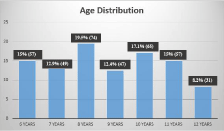
Graphic 1: Descriptive analysis of the distribution by age.
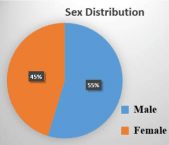
Graphic 2: Descriptive analysis of the distribution by sex.
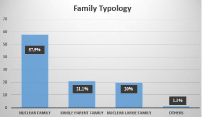
Graphic 3: Descriptive analysis of the distribution by family typology.
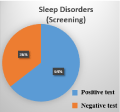
Graphic 4: Descriptive analysis of the distribution by sleep disorders positive
tests.
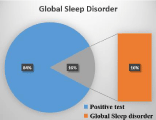
Graphic 5: Descriptive analysis of the distribution by GSD in positive tests.
The prevalence of each dimension included in the test found the following results (Graphic 6): 110 positive tests for problems at the beginning and maintenance of sleep (28.9%); 132 positive tests for respiratory problems (34.7%); 12 positive tests for arousal disorders (3.2%); 120 positive test for alterations in the sleep-wake transition (31.6%); 86 positive test for excessive sleepiness (22.6%), 72 positive tests for hyperhidrosis (18.9%) and 52 children had more than two affected items.
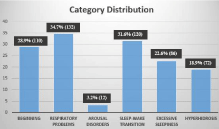
Graphic 6: Descriptive analysis of the distribution by GSD category.
Discussion and Conclusion
In Mexico it is estimated that approximately 30% of the population has some alteration in their sleep habits. In Spain, a prevalence of 13-27% is reported in the pediatric population between 4 and 12 years; however, in our study we found a prevalence of 64.5% of positive tests for sleep disorder, with a prevalence of 15.5% of global sleep disorder, which is consistent with what is published internationally [7]. Martins et al (2013), found a prevalence of 59.4% of sleep disorders in children with single-parent families, however in our results the children affected from single-parent families were only 21.1%, with nuclear families being the largest proportion (57.9%). Espinoza-Mejía et al (2011), reported a prevalence of 23.81% of sleep disorders secondary to respiratory problems in children with disabilities, we found a prevalence of 34.7% of respiratory problems in children without disabilities [3]. Liu et al (2016), in a study with 3979 participants found a prevalence of 17.2% of excessive sleepiness in primary school children and associated this prevalence with low school performance and risk of presenting depression [11]. Moo- Esthella et al (2011), found that there was no relationship between depression and the appearance of some sleep disorder [12]. We found in our study a prevalence of 22.6% of excessive sleepiness in our population.
Sleep disorders are a frequent problem in children and affect the different levels of development, it is important to carry out screening studies that allow us to identify and initiate treatment in a timely manner. First contact physicians should be trained to search for these diseases in the pediatric population and complement the screening with specific diagnostic tests for the affected category. Restful sleep is considered a protective factor against mental and metabolic diseases in children and adolescents, so it is important to have a good quality of sleep and educate our population to avoid situations that could affect their quality of life related to sleep. In conclusion, our study establishes an antecedent on the quality of sleep and sleep disorders in children of Tijuana, so it is recommended to create educational strategies for parents and children affected by this type of disorders.
References
- Contreras A. El sueño a lo largo de la vida y sus implicaciones en salud. Rev Med Clin Condes. 2013; 24: 341-349.
- Bertran K, Mesa T, Rosso K, Krakowiak M, Pincheira E, Brockmann P. Diagnostic accuracy of the Spanish version of the Pediatric Sleep Questionnaire for screening of obstructive sleep apnea in habitually snoring children. Sleep Medicine. 2015; 16: 631-636.
- Espinosa-Mejía MJ, Ortiz-Pintor I. Frecuencia de trastornos del sueño en niños con discapacidad y alteraciones respiratorias. Rev Mex Med Fis Rehab. 2011; 23: 115-122.
- Diagnóstico y tratamiento de los Trastornos del sueño. Guía de Referencia Rápida, Ciudad de México: CENETEC; 2010.
- Andrare L. Relacion entre problemas habituales del sueño con déficit atencional y trastornos conductuales en niños. Rev Med Clin Condes. 2013; 24: 494-500.
- Urretarazu E, Escobar F, Iriarte J. El sueño y su patología. Medicine. 2015; 11: 4385-4394.
- Ferré A. Síndrome de fatiga crónica y los trastornos del sueño: relaciones clínicas y dificultades diagnósticas. Neurología. 2018; 33: 385-394.
- Rojas-Ramirez A, Garcia-Mendez M. Funcionamiento familiar como predictor de la alexitimia de acuerdo al índice de masa corporal. Acta de Investigación Psicológica. 2016: 6: 2469–2476.
- Gutiérrez-Saldaña P, Camacho-Calderón N, Martínez-Martínez M. Autoestima, funcionalidad familiar y rendimiento escolar en adolescentes. Aten Primaria. 2007; 39: 597-601.
- Martins A, Chaves P, Papoila A, Loureiro H. The family role in children's sleep disturbances: Results from a cross-sectional study in a Portuguese Urban pediatric population. Sleep Sciencie. 2015; 8: 108-114.
- Liu J, Liu X, Ji X, Wang Y, Zhou G. Sleep disordered breathing symptoms and daytime sleepiness are associated with emotional problems and poor school performance in children. Psychiatry Research. 2016; 242: 218-225.
- Moo-Estrella J, Valencia-Flores M, Ulloa-Flores R, Ostrosky-Solis F, Reyes-Lagunes I. Estructura del sueño y funciones ejecutivas en niños con depresión. Salud Mental. 2011; 34: 459-468.
